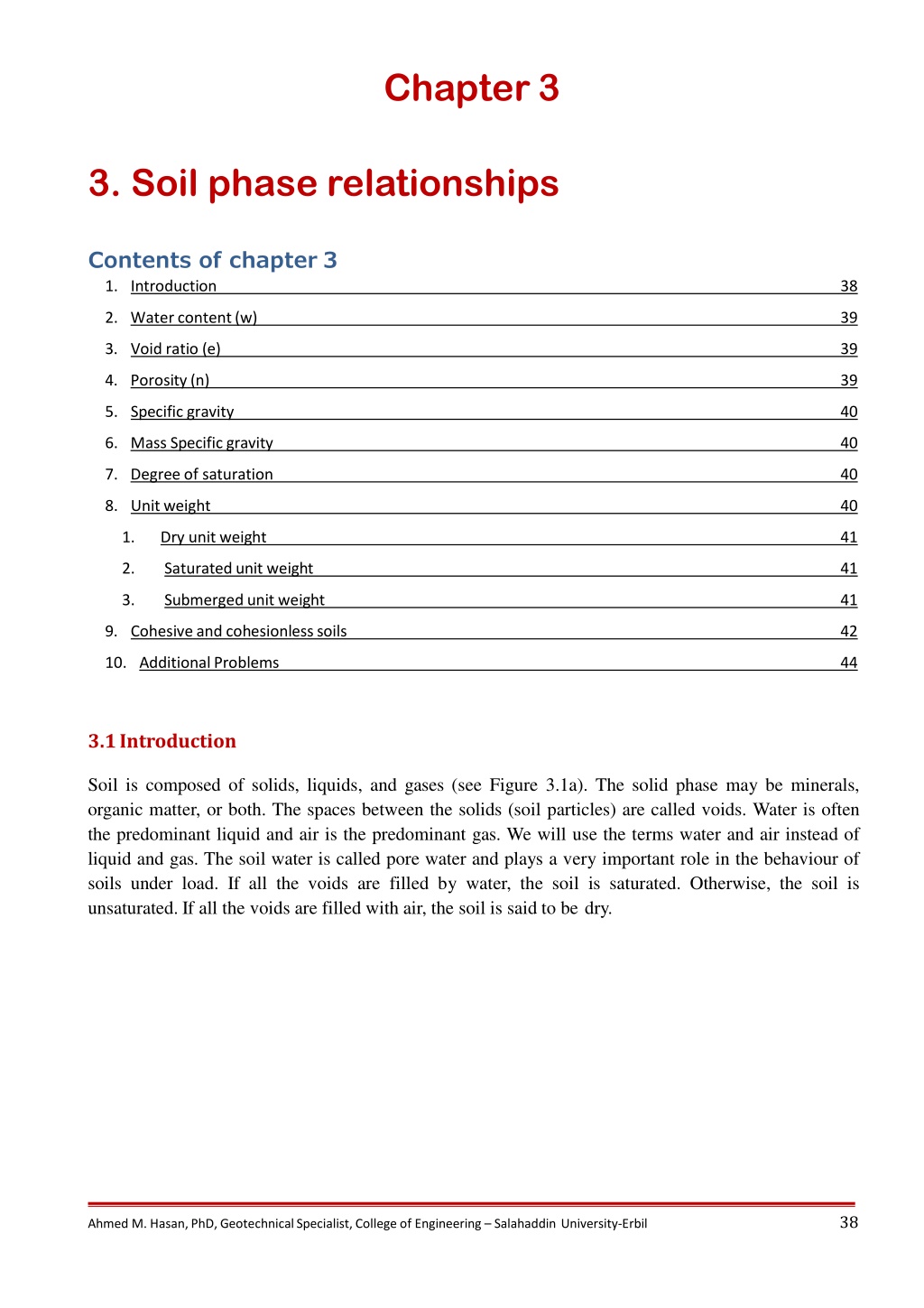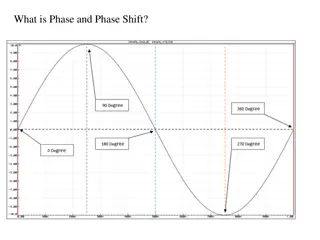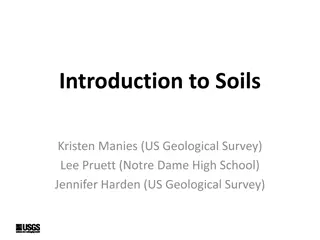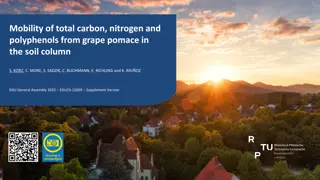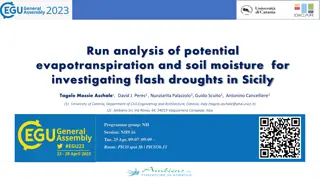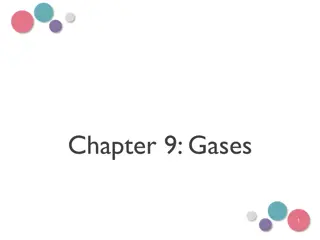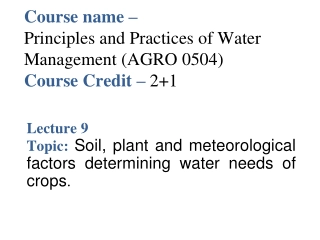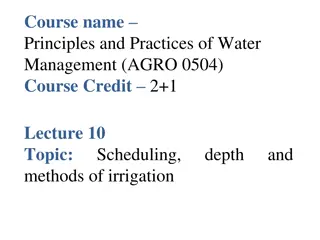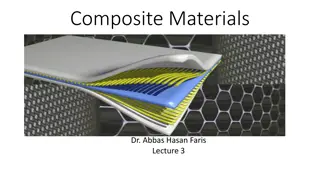Understanding Soil Phase Relationships and Properties
Soil consists of solids, liquids, and gases with voids in between. Water content, void ratio, porosity, specific gravity, mass specific gravity, degree of saturation, and unit weight are key parameters in characterizing soil behavior. Relationships between these properties are crucial for geotechnical analysis and design.
Download Presentation
Please find below an Image/Link to download the presentation.
The content on the website is provided AS IS for your information and personal use only. It may not be sold, licensed, or shared on other websites without obtaining consent from the author. Download presentation by click this link. If you encounter any issues during the download, it is possible that the publisher has removed the file from their server.
Presentation Transcript
Chapter 3 3. Soil phase relationships Contents of chapter 3 1. Introduction 38 2. Watercontent(w) 39 3. Void ratio (e) 39 4. Porosity(n) 39 5. Specific gravity 40 6. Mass Specificgravity 40 7. Degreeof saturation 40 8. Unitweight 40 1. Dry unitweight 41 2. Saturated unit weight 41 3. Submergedunitweight 41 9. Cohesiveand cohesionless soils 42 10. AdditionalProblems 44 3.1Introduction Soil is composed of solids, liquids, and gases (see Figure 3.1a). The solid phase may be minerals, organic matter, or both. The spaces between the solids (soil particles) are called voids. Water is often the predominant liquid and air is the predominant gas. We will use the terms water and air instead of liquid and gas. The soil water is called pore water and plays a very important role in the behaviour of soils under load. If all the voids are filled by water, the soil is saturated. Otherwise, the soil is unsaturated. If all the voids are filled with air, the soil is said to be dry. 38 Ahmed M. Hasan, PhD, Geotechnical Specialist, College of Engineering Salahaddin University-Erbil
Figure 3.1 Soilphases We can idealize the three phases of soil, as shown in Figure 3.1b. The physical parameters of soils are influenced by the relative proportions of each of these phases. The total volume of the soil is the sum of the volume of solids (Vs), volume of water (Vw), and volume of air (Va); that is, where is the volume of voids. The weight of the soil is the sum of the weight of solids (ws) and the weight of water (ww). The weight of air is negligible. Thus, The following definitions have been established to describe the proportion of each constituent in a soil. Each equation can be presented with different variables. The most popular and convenient forms are given. You should try to memorize these relationships. 3.2 Water content (w) is the ratio, often expressed as a percentage, of the weight of water to the weight ofsolids: If organic matter is present in a soil, it may oxidize and decompose at 110 5 C 3.Void ratio (e) is the ratio of the volume of void space to the volume of solids. Void ratio is usually expressed as a decimal quantity: 0< e < 4.Porosity (n) is the ratio of the volume of voids to the total volume. Porosity is usually expressed as a percentage: 0< n <1 39 Ahmed M. Hasan, PhD, Geotechnical Specialist, College of Engineering Salahaddin University-Erbil
Porosity and void ratio are related by theexpressions Prove Equations 3.7 and 3.8 ? H.W 3.5 Specific gravity (Gs) is the ratio of the weight of the soil solids to the weight of water of equalvolume: 3.6 Mass Specific gravity (Gm) The Mass specific gravity of a soil may be defined as the ratio of mass or bulk unit weight of soil to the unit weight of water at the standard temperature (4 C). This is denoted by the letter symbol Gmand is givenby: 3.7 Degree of saturation (Sr) Degree of saturation (Sr) is the ratio, often expressed as a percentage, of the volume of water to the volume ofvoids: Prove that ? H.W. 3.8 Unit weight is the weight of a soil per unit volume. The term bulk (total) unit weight ( t) will be devoted to unit weight: ( ) 40 Ahmed M. Hasan, PhD, Geotechnical Specialist, College of Engineering Salahaddin University-Erbil
Special cases of unit weight: 3.8.1 Dry unit weight (Sr = 0): For dry soil, , w=0% and . Then Equation 3.13 reduces to ( ) Then Equations 3.13 and 3.15 results in Voids Derive if Vs=1. H.W. e=Vv V Solids Vs=1 3.8.2 Saturated unit weight (Sr =1): ( ) 3.8.3 Submerged unit weight : For unsaturatedsoils ( ) or For saturatedsoils ( ) The density of water and is 1000 Kg/m3 = 1 g/cm3 In t h e most applications it is not the mass that is important, but the force due to the mass, and the weight, W, is related to the mass, M, by therelation 41 Ahmed M. Hasan, PhD, Geotechnical Specialist, College of Engineering Salahaddin University-Erbil
where g g is the acceleration due to gravity. If M is measured in Kg and W in kN, g = 9.8 m/s2 Note converting Kg to kN: W= M (Kg) (9.8)/1000 = kN 3.9 Cohesive and cohesionless soils Cohesive soils: under dry or saturated or unsaturated conditions, grains of soils are stick together; a force is required to separate them. Cohesionless soils: under dry or saturated conditions, grains of soils fall apart, whereas under unsaturated conditions, the grains are stick together due to surface tension, see the next chapter (i. e. suction). Example3.1: A soil has an in-situ void ratio eo=1.87, w=60% and Gs=2.75. What are the moist unit weight and degree of saturation? Assume that Vs=1m3. Solution: 42 Ahmed M. Hasan, PhD, Geotechnical Specialist, College of Engineering Salahaddin University-Erbil
Example3.2 A soil has porosity of 32.5%. For volume of 1 cm3, how much water is required to saturate the soil? Solution: Example3.3 An airport runway fill needs 600 000 m3of soil compacted to a void ratio of 0.75. There are two borrow pits A and B from where the required soil can be taken and transported to the site. Which of the two borrowpits wouldbe moreeconomical? Borrowpit A B In situ voidratio 0.80 1.70 Transportationcost 5USD 2.5USD Solution: 43 Ahmed M. Hasan, PhD, Geotechnical Specialist, College of Engineering Salahaddin University-Erbil
3.10 AdditionalProblems P3.1: One cubic metre of wet soil weighs 19.80 kN. If the specific gravity of soil particles is 2.70 and water content is 11%, find a) the void ratio, b) dry density and c) degree ofsaturation. P3.2: A sample of clay taken from a natural stratum was found to be partially saturated and when tested in the laboratory gave the following results. Compute the degree ofsaturation. Specific gravity of soil particles =2.6; wet weight of sample = 2.50 N; dry weight of sample = 2.10 N; and volume of sample= 150cm3. P3.3: The mass specific gravity of a fully saturated specimen of clay having a water content of 30.5% is 1.96. On oven drying, the mass specific gravity drops to 1.60. Calculate the specific gravity of clay. P3.4: Aggregates from a material storage site are required for the embankment of a roadway. The porosity of the aggregates at the storage site is 80%, and the desired porosity of the compacted aggregates in the embankment is 20%. For a section of the embankment 7.6m wide x 0.61m compacted thickness x 305m long, calculate the volume of aggregates required. P3.5: An embankment for a highway is to be constructed from a soil compacted to a dry unit weight of 18kN/m3. The clay has to be trucked to the site from a borrow pit. The bulk unit weight of the soil in the borrow pit is 17kN/m3and its natural water content is 5%. Calculate the volume of clay from the borrow pit required for 1 cubic meter of embankment. The swell factor is 1.2 (20% free swell). Assume Gs=2.7. P3.6: For an unsaturated (partially) soil deposit at a construction site, water content, w=15%, void ratio, e=0.6 and specific gravity of soil particles/solids, Gs=2.67. Determine the following (a) degree of saturation, (b) dry unit weight, and (c) weight of water required to fully saturated 5 m3 ofsoil. Answers: (a) , (b) (c) 44 Ahmed M. Hasan, PhD, Geotechnical Specialist, College of Engineering Salahaddin University-Erbil
P3.7: A 0.9m3 soil specimen weighs (1734693g) and has a water content of 9%. The specific gravity of the soil solids is 2.7. Calculate (1) t, (2) d, (3) e, (4) n, (5) Vw, and (6) Sr (7) sat (8) sub Answers: = 18.9 kN/m3 d =17.33 kN/m3 e = 0.528 , n =0.346, Vw= 0.143m3 , Sr = 45.9% sat= 20.72 kN/m3 , sub= 10.91 kN/m3 P3.8: For a saturated soil, water content was 40% and Gs was 2.71. Determine the saturated and dry unit weights. Answers: e = 1.084 , , P3.9: A sample of moist clay soil has e = 0.78, Sr= 0.93 and Gs=2.7. Determine the dry and wet unit weights and water content. Answer: 14.88kN/m3, 18.88 1kN/m3and 0.27 P3.10: A wet sample of sand directly above the water table was found to have a natural moisture content of 15% and a unit weight of 18.84 kN/m3. Laboratory tests on a dried sample indicated values of emin= 0.50 and emax= 0.85 for the densest and loosest states respectively. Compute the degree of saturation and the relative density.Assume Gs = 2.65. Answer: Sr= 67.7% , e = 0.587, Dr =75.14% P3.11: Diameter and height of a soil specimen are 38mm and 76mm respectively, in its natural condition weighs 160.0g. When dried completely in an oven the specimen Weighs 130.5 g. The value of Gs is 2.73. What is the degree of saturation of thespecimen? Answer:77.12% P3.12: For a soil, show that ( ) 45 Ahmed M. Hasan, PhD, Geotechnical Specialist, College of Engineering Salahaddin University-Erbil
